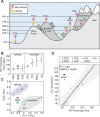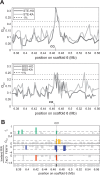Genetic basis and evolution of rapid cycling in railway populations of tetraploid Arabidopsis arenosa
- PMID: 29975688
- PMCID: PMC6049958
- DOI: 10.1371/journal.pgen.1007510
Genetic basis and evolution of rapid cycling in railway populations of tetraploid Arabidopsis arenosa
Abstract
Spatially structured plant populations with diverse adaptations provide powerful models to investigate evolution. Human-generated ruderal habitats are abundant and low-competition, but are challenging for plants not adapted to them. Ruderal habitats also sometimes form networked corridors (e.g. roadsides and railways) that allow rapid long-distance spread of successfully adapted variants. Here we use transcriptomic and genomic analyses, coupled with genetic mapping and transgenic follow-up, to understand the evolution of rapid cycling during adaptation to railway sites in autotetraploid Arabidopsis arenosa. We focus mostly on a hybrid population that is likely a secondary colonist of a railway site. These mountain railway plants are phenotypically similar to their cosmopolitan cousins. We thus hypothesized that colonization primarily involved the flow of adaptive alleles from the cosmopolitan railway variant. But our data shows that it is not that simple: while there is evidence of selection having acted on introgressed alleles, selection also acted on rare standing variation, and new mutations may also contribute. Among the genes we show have allelic divergence with functional relevance to flowering time are known regulators of flowering, including FLC and CONSTANS. Prior implications of these genes in weediness and rapid cycling supports the idea that these are "evolutionary hotspots" for these traits. We also find that one of two alleles of CONSTANS under selection in the secondary colonist was selected from rare standing variation in mountain populations, while the other was introgressed from the cosmopolitan railway populations. The latter allele likely arose in diploid populations over 700km away, highlighting how ruderal populations could act as allele conduits and thus influence local adaptation.
Conflict of interest statement
The authors have declared that no competing interests exist.
Figures






Similar articles
-
Single Geographic Origin of a Widespread Autotetraploid Arabidopsis arenosa Lineage Followed by Interploidy Admixture.Mol Biol Evol. 2015 Jun;32(6):1382-95. doi: 10.1093/molbev/msv089. Epub 2015 Apr 10. Mol Biol Evol. 2015. PMID: 25862142
-
Habitat-Associated Life History and Stress-Tolerance Variation in Arabidopsis arenosa.Plant Physiol. 2016 May;171(1):437-51. doi: 10.1104/pp.15.01875. Epub 2016 Mar 3. Plant Physiol. 2016. PMID: 26941193 Free PMC article.
-
Standing genetic variation in FRIGIDA mediates experimental evolution of flowering time in Arabidopsis.Mol Ecol. 2009 May;18(9):2039-49. doi: 10.1111/j.1365-294X.2009.04145.x. Epub 2009 Mar 20. Mol Ecol. 2009. PMID: 19317844
-
[From population genetics to population genomics of forest trees: integrated population genomics approach].Genetika. 2006 Oct;42(10):1304-18. Genetika. 2006. PMID: 17152702 Review. Russian.
-
Identifying adaptive alleles in the human genome: from selection mapping to functional validation.Hum Genet. 2021 Feb;140(2):241-276. doi: 10.1007/s00439-020-02206-7. Epub 2020 Jul 29. Hum Genet. 2021. PMID: 32728809 Review.
Cited by
-
The Chromatin-Remodeling Factor PICKLE Antagonizes Polycomb Repression of FT to Promote Flowering.Plant Physiol. 2019 Oct;181(2):656-668. doi: 10.1104/pp.19.00596. Epub 2019 Aug 3. Plant Physiol. 2019. PMID: 31377725 Free PMC article.
-
Male and female recombination landscapes of diploid Arabidopsis arenosa.Genetics. 2022 Mar 3;220(3):iyab236. doi: 10.1093/genetics/iyab236. Genetics. 2022. PMID: 35100396 Free PMC article.
-
Interspecific introgression mediates adaptation to whole genome duplication.Nat Commun. 2019 Nov 18;10(1):5218. doi: 10.1038/s41467-019-13159-5. Nat Commun. 2019. PMID: 31740675 Free PMC article.
-
Relaxed purifying selection in autopolyploids drives transposable element over-accumulation which provides variants for local adaptation.Nat Commun. 2019 Dec 20;10(1):5818. doi: 10.1038/s41467-019-13730-0. Nat Commun. 2019. PMID: 31862875 Free PMC article.
-
Whole-genome duplication increases genetic diversity and load in outcrossing Arabidopsis arenosa.Proc Natl Acad Sci U S A. 2025 Aug 5;122(31):e2501739122. doi: 10.1073/pnas.2501739122. Epub 2025 Jul 30. Proc Natl Acad Sci U S A. 2025. PMID: 40737318
References
-
- Hall MC, Willis JH. Divergent selection on flowering time contributes to local adaptation in Mimulus guttatus populations. Evolution. 2006. December;60(12):2466–77. - PubMed
-
- Fox GA. Drought and the evolution of flowering time in desert annuals. American Journal of Botany. 1990. 77: 1508–18.
-
- Sherrard ME, Maherali H. The adaptive significance of drought escape in Avena barbata, an annual grass. Evolution (N Y). 2006. December;60(12):2478–89. - PubMed
-
- Mckay JK, Richards JH, Mitchell-Olds T. Genetics of drought adaptation in Arabidopsis thaliana: I. Pleiotropy contributes to genetic correlations among ecological traits. Mol Ecol. 2003. May;12(5):1137–51. - PubMed
Publication types
MeSH terms
Grants and funding
LinkOut - more resources
Full Text Sources
Other Literature Sources

